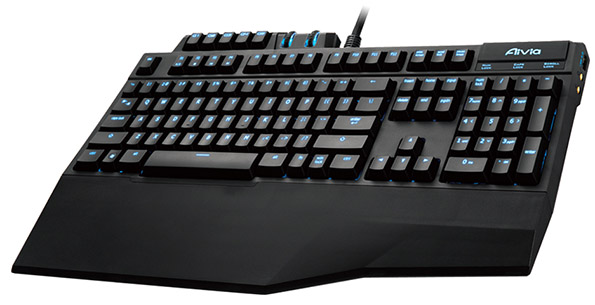Gigabyte Osmium Keyboard: Great Design, Poor Accuracy
Introduction
After 25 years of typing on keyboards, I've field-tested everything from IBM's legendary Mode M to the sort of $4.99 specials that were, as far as I could tell, constructed from styrofoam, packing peanuts, and pocket lint. About a year ago, I made the jump to a pair of mechanical keyboards and haven't looked back since.
Marco wrote an excellent explanation on the various types of keyboard switches and capabilities that I'd recommend reading for more background info. The board on the table today is Gigabyte's Aivia Osmium, and it's an impressive beauty.
The Osmium includes a USB 2 port, USB 3 port, headphone/microphone jacks, five macro keys, five profile settings, a double-set of stands to adjust the keyboard's height, and independent wheels for controlling the backlight and audio. The wheels can be adjusted up and down to change levels or clicked on and off.
The stands on the underside of the keyboard are thick and sturdy, with non-skid foam mats. Once you've got this keyboard set up, it isn't going anywhere. Everything about the physical design is sturdy and well thought out. By putting the macro buttons and scroll wheel at the top of the board, Gigabyte has ensured that the keyboard will fit on a desk that's only wide enough for a regular keyboard.
Now let's talk about the keys themselves. Mechanical switches are categorized by whether they are linear, tactile, and/or clicky. A linear switch is a switch that requires the same amount of force to fully depress a key and one that doesn't transmit a "bump" to the user's finger. A tactile switch is a switch that has a "bump" built into the actuation. This provides a second level of feedback beyond a keystroke appearing on the screen. A clicky switch gives a third level of feedback -- there's a distinct, audible sound.


The animated GIFs above show two different switches in motion. The linear MX Cherry Red is on the left, while the MX Blues are clicky and tactile are on the right.
We're comparing the Aivia Osmium against a Solidtek 6600U and an ABS M1. Both of these keyboards use what are called simplified ALPS switches. The 6600U uses ALPS White switches (clicky, tactile) while the ABS M1 uses ALPS Black switches (non-clicky, tactile). The Osmium, in contrast, uses Cherry MX Red switches, which are linear. The ALPS switches work on a slightly different principle than the Cherry MX Blue pictured above but produce a similar effect.
Next up, there's actuation force. Actuation force is the amount of effort it takes to depress a key. Both rubber dome (traditional) and mechanical keyboards can vary widely here. The actuation force of our three boards is shown in the graph below:

The Osmium takes a much lighter touch than either of the other two. We'll discuss why that could be problematic for some users a little farther on in the review. Although, also keep in mind that some users prefer a lighter touch.
Marco wrote an excellent explanation on the various types of keyboard switches and capabilities that I'd recommend reading for more background info. The board on the table today is Gigabyte's Aivia Osmium, and it's an impressive beauty.
The Osmium includes a USB 2 port, USB 3 port, headphone/microphone jacks, five macro keys, five profile settings, a double-set of stands to adjust the keyboard's height, and independent wheels for controlling the backlight and audio. The wheels can be adjusted up and down to change levels or clicked on and off.
The stands on the underside of the keyboard are thick and sturdy, with non-skid foam mats. Once you've got this keyboard set up, it isn't going anywhere. Everything about the physical design is sturdy and well thought out. By putting the macro buttons and scroll wheel at the top of the board, Gigabyte has ensured that the keyboard will fit on a desk that's only wide enough for a regular keyboard.
Now let's talk about the keys themselves. Mechanical switches are categorized by whether they are linear, tactile, and/or clicky. A linear switch is a switch that requires the same amount of force to fully depress a key and one that doesn't transmit a "bump" to the user's finger. A tactile switch is a switch that has a "bump" built into the actuation. This provides a second level of feedback beyond a keystroke appearing on the screen. A clicky switch gives a third level of feedback -- there's a distinct, audible sound.


The animated GIFs above show two different switches in motion. The linear MX Cherry Red is on the left, while the MX Blues are clicky and tactile are on the right.
We're comparing the Aivia Osmium against a Solidtek 6600U and an ABS M1. Both of these keyboards use what are called simplified ALPS switches. The 6600U uses ALPS White switches (clicky, tactile) while the ABS M1 uses ALPS Black switches (non-clicky, tactile). The Osmium, in contrast, uses Cherry MX Red switches, which are linear. The ALPS switches work on a slightly different principle than the Cherry MX Blue pictured above but produce a similar effect.
Next up, there's actuation force. Actuation force is the amount of effort it takes to depress a key. Both rubber dome (traditional) and mechanical keyboards can vary widely here. The actuation force of our three boards is shown in the graph below:

The Osmium takes a much lighter touch than either of the other two. We'll discuss why that could be problematic for some users a little farther on in the review. Although, also keep in mind that some users prefer a lighter touch.









